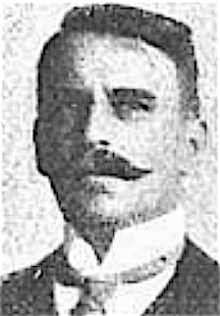
Ambrose Macdonald Poynter [also known as Sir Ambrose Macdonald Poynter] was born in London, England on 26 September 1867. His father was the painter Edward John Poynter (1836-1919) and his grandfather was the architect and painter Ambrose Poynter (1796-1886). He studied at the South Kensington Art Schools [now the Royal College of Art] in in London 1886 and at the Royal Academy Schools in London from 1889. He was articled to George Aitchison (1825-1910) in London from 1887 to 1892. He was then an improver with George Frederick Bodley (1827-1907) until 1893 when he established his own architectural firm in London.
Apart from brief partnerships with Ernest Wilmott (1871-1916) and with George Harry Wenyon (1878-1946), Poynter worked as an independent architect. Projects included alterations to the Manor House, Mount Grace Priory in Northallerton, Yorkshire (c.1904); alterations to Vernon House at Park Place, St. James's, London (1906-08); additions to Polesden Lacey, near Dorking in Surrey (c.1907); the Comptair National d'Escompte Pavilion at the Franco-British Exhibition in London (1908); the design of the Village Hall in Ingleby Arncliffe, Yorkshire (1910). With Sir Lawrence Alma-Tadema (1836-1912), he also designed the marble balustrade around the Atheneum Club in London.
Poyter was elected a member of the Art Workers Guild (AWG) and a Fellow of the Royal Institute of British Architects (FRIBA) in 1906.
In addition to his work as an architect, he was also a painter. He exhibited at the Royal Academy in London from 1894 to 1917, and at the New Gallery in London. He also participated in the 5th exhibition of the Arts & Crafts Exhibition Society in London in 1896. A watercolour by him entitled "Rottingdean from Churchyard - 1887" is in the permanent collection of the National Trust property Batemans in Sussex.
Poynter was awarded the RIBA Silver Medal (Essays) in 1889. Poynter lived in London, Buenos Aires (c.1910-1912), and in Botley, Hampshire, England. During his time in Argentina, Poyter designed the British Memorial Clock in Buenos Aires, was a juror and British local representative for the International Fine Art Exhibition and for the Exhibition of Hygiene in Buenos Aires in 1910.
His address was given as 4 Bloombury Square, London in 1894 and 1895; 2 Gray's Inn Square, London in 1896; 1 Great College Street, Westminster, London in 1898; 148a Sloane Street, London in 1900 and 1902; ; 8 Southampton Street, Bloomsbury Square, London in 1905; 1 Raymond Buildings, Gray's Inn, London in 1909; 430 Baetolomé Mitre, Buenos Airies, Argentina in 1912; 70 Addison Road, Kensington, London in 1913; and 8 Grafton Street, London in 1917. He died at 26 Chester Terrace, Eaton Square, Middlesex [now London] on 31 May 1923. His address at the time of his death was Ivy Cottage, Botley, Hampshire.
Architectural projects included alterations to the Manor House, Mount Grace Priory in Northallerton, Yorkshire (c.1904); alterations to Vernon House at Park Place, St. James's, London (1906-08); additions to Polesden Lacey, near Dorking in Surrey (c.1907); the Comptair National d'Escompte Pavilion at the Franco-British Exhibition in London (1908); the design of the Village Hall in Ingleby Arncliffe, Yorkshire (1910). With Sir Lawrence Alma-Tadema (1836-1912), he also designed the marble balustrade around the Atheneum Club in London.
______
See also British Listed Buildings; Historic England [links below]
Directory of British Architects 1834-1914. Compiled by Antonia Brodie, et al. Volume 2: L-Z. London; New York: British Architectural Library, Royal Institute of British Architects/Continuum, 2001
Gray, A. Stuart. Edwardian architecture: a biographical dictionary. London: Gerald Duckworth & Co., Ltd., 1985
‘Obituary’. The Builder vol. 124, 8 June 1923 p. 928
‘Obituary’. RIBA Journal 16 June 1923 p. 504